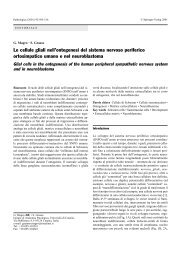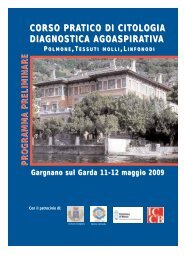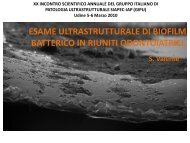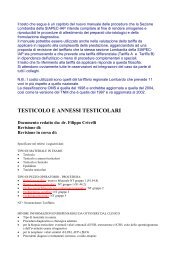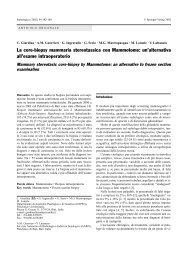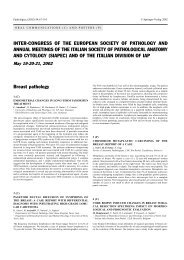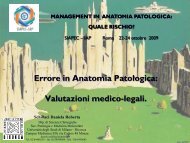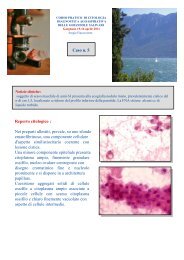pag. 216-318 - Siapec
pag. 216-318 - Siapec
pag. 216-318 - Siapec
Create successful ePaper yourself
Turn your PDF publications into a flip-book with our unique Google optimized e-Paper software.
238<br />
COMUNICAZIONI E POSTER<br />
with others 3 . This may be due to an accumulation of molecular<br />
alterations in histologically normal bronchial mucosa in<br />
the development of SCC of the lung.<br />
References<br />
1<br />
Belinsky SA, et al. J Clin Ligand Assay 2002;25:95-9.<br />
2<br />
Tanaka R, et al. Cancer 2005;103:608-15.<br />
3<br />
Caballero OL, et al. Genes, Chromosomes and Cancer 2001;32:119-<br />
25.<br />
EGFR expression and mutation analysis in<br />
lung adenocarcinoma and tumor-associated<br />
atypical adenomatous hyperplasia<br />
G. Sartori, N. Bigiani, L. Schirosi, A. Cavazza ** , G. Rossi,<br />
A. Marchioni * , F. Maselli * , A. Maiorana, M. Migaldi,<br />
G.P. Trentini<br />
Sezione di Anatomia Patologica, * Malattie dell’Apparato<br />
Respiratorio, Università di Modena e Reggio Emilia; ** Unità<br />
Operativa di Anatomia Patologica, Ospedale SMN, Reggio<br />
Emilia<br />
Introduction<br />
Epidermal Growth Factor Receptor (EGFR) is a tyrosine<br />
kinase receptor of the erbB family deeply involved in nonsmall<br />
cell lung cancer growth mechanisms. Recently, the<br />
finding of somatic mutations of EGFR has been correlated<br />
with nonsmokers, female sex and histologic subtype of<br />
adenocarcinoma (ADC) with bronchioloalveolar (BAC)<br />
features and implicated in the clinical response using selective<br />
EGFR-inhibitors. We analysed the EGFR status in<br />
lung ADC and in foci of tumor-associated atypical adenomatous<br />
hyperplasia (AAH), the pre-invasive lesion of<br />
ADC, in order to explore the role of EGFR mutation as early<br />
molecular event in lung carcinogenesis and the possible<br />
clonal relation between infiltrative and pre-invasive lesions<br />
of ADC.<br />
Methods<br />
We identified 8 cases of pulmonary ADC in which multiple<br />
foci of AAH were present in the normal adjacent parenchyma.<br />
In all cases, several 4-micron thick sections were obtained<br />
from formalin-fixed and paraffin-embedded representative<br />
blocks. Immunohistochemical analysis was performed<br />
using EGFR mAb (Dako) in an automated immunostainer<br />
(Benchmark, Ventana). Sequencing analyses<br />
were performed by PCR and EGFR exons 18, 19 and 21<br />
were investigated.<br />
Results<br />
The cases consisted of 4 men and 4 women (7 smokers and 1<br />
nonsmoker) with mixed acinar ADC with BAC (3 non-mucinous,<br />
1 mucinous), 1 mucinous-BAC, 1 papillary ADC, 1<br />
moderately-differentiated ADC and 1 non-mucinous BAC.<br />
EGFR expression was noted in all cases of ADC, BAC and<br />
AAH with a membrane pattern mainly restricted to mucinous-BAC.<br />
EGFR mutation analysis showed an identical<br />
puntiform mutation (L858R) on exon 21 in 1 case (non-mucinous<br />
BAC in a nonsmoker woman) both in BAC and AAH.<br />
No other mutational events were detected in the remaining<br />
lesions.<br />
Conclusions<br />
EGFR expression in neoplastic and pre-invasive lesions document<br />
a key role of this molecule in lung cancer, but did not<br />
permit a reliable selection of patients that could benefit from<br />
targeted therapies with small molecules. Although further investigations<br />
are required on larger series, the finding of an<br />
identical EGFR mutation in only 1 non-mucinous BAC and<br />
tumor-associated AAH and the lack of such mutations in the<br />
other combined lesions seems to suggest a clonal origin and<br />
a carcinogenetic early role of EGFR in a small subset of patients<br />
with lung cancer.<br />
Mesotelioma maligno primitivo peritoneale<br />
localizzato nel sacco erniario. Analisi genetica<br />
di due casi<br />
A. Scattone, A. Pennella * , M. Gentile ** , M. Testini *** , AL<br />
Buonadonna ** , A. Gentile, D. Galetta **** , L. Pollice, G.<br />
Serio<br />
Dipartimento di Anatomia Patologica, Università, Bari; * Dipartimento<br />
di Scienze Chirurgiche, Università, Foggia; **<br />
Divisione Genetica, IRCCS, Castellana Grotte (BA); *** Dipartimento<br />
Scienze Chirurgiche, Università, Bari; **** U.O.<br />
Oncologia Sperimentale e Clinica, IRCCS, Bari<br />
Introduzione<br />
Il mesotelioma maligno primitivo del sacco erniario (MM-<br />
PSE) è una neoplasia estremamente rara la cui prognosi risulta<br />
essere meno aggressiva della forma peritoneale diffusa<br />
e non presenta correlazione con l’esposizione all’asbesto. Il<br />
trattamento chirurgico associato alla radioterapia migliorano<br />
il decorso clinico della malattia e il tempo di sopravvivenza<br />
riportato in 3 pazienti deceduti (totale 7 casi descritti), varia<br />
tra 5 e 10 anni.<br />
Nel mesotelioma diffuso studi molecolari individuano perdite<br />
cromosomiche ricorrenti che rivestono un importante significato<br />
diagnostico. Scopo del presente lavoro è l’individuazione<br />
di alterazioni genetiche in due casi di MMPSE con<br />
CGH (Comparative Genomic Hybridization) e con analisi dei<br />
microsatelliti.<br />
Metodi e risultati<br />
Riportiamo due casi di MMPSE osservati incidentalmente<br />
in due maschi di anni 71 rispettivamente, sottoposti ad intervento<br />
di ernioplastica inguinale sinistra complicata. Entrambi<br />
i pazienti non riferivano nella storia clinico-anamnestica<br />
esposizione all’asbesto né precedenti interventi chirurgici<br />
addominali. Macroscopicamente il sacco erniario mostrava<br />
numerosi noduli di dimensioni variabili (1-3 cm nel<br />
caso 1 e fino a 10 cm nel caso 2). La diagnosi istologica di<br />
mesotelioma maligno veniva confermata dall’indagine immunoistochimica<br />
condotta su sezioni di tessuto paraffinato<br />
con metodo convenzionale (avidina-biotina-perossidasi)<br />
utilizzando anticorpi monoclonali: CK 5/6, calretinina,<br />
EMA, vimentina, CEA, BerEp4, HMB-1, leuM1, Ki-67<br />
(Mib-1). L’analisi molecolare è stata effettuata su DNA<br />
estratto da campioni di tessuto paraffinato con tecniche<br />
standardizzate. L’indagine con CGH non ha evidenziato alterazioni<br />
cromosomiche e l’analisi dei microsatelliti instabilità.<br />
I due pazienti sono stati sottoposti a cicli di chemioterapia<br />
post-chirurgica: un paziente moriva dopo 53 mesi dall’intervento<br />
(Caso 1), l’altro risulta vivente e libero da ripresa di<br />
malattia a 36 mesi dalla diagnosi (Caso 2).<br />
Conclusioni<br />
Lo studio molecolare suggerirebbe l’esistenza di una via cancerogenetica<br />
distinta da quella del MM diffuso e ipotizzerebbe<br />
il coinvolgimento di meccanismi epigenetici nello sviluppo<br />
del MMPSE.





